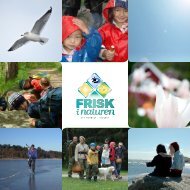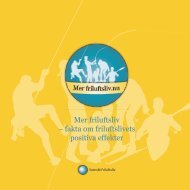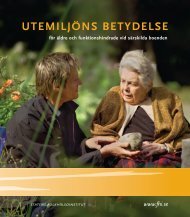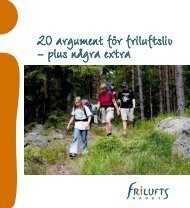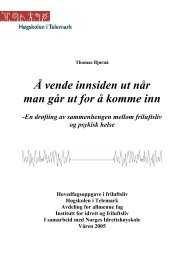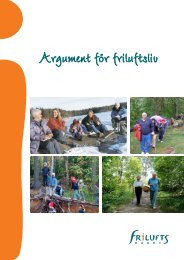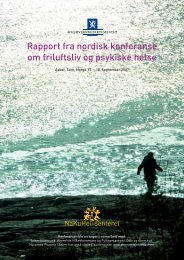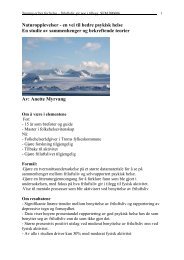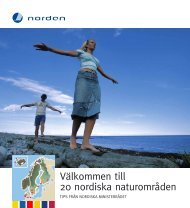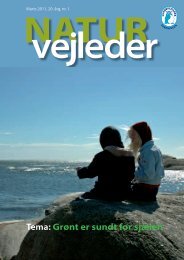Green Care: A Conceptual Framework - Frisk i naturen
Green Care: A Conceptual Framework - Frisk i naturen
Green Care: A Conceptual Framework - Frisk i naturen
You also want an ePaper? Increase the reach of your titles
YUMPU automatically turns print PDFs into web optimized ePapers that Google loves.
Smith, K., Avis, N. and Assmann, S. (1999) ‘Distinguishing between quality of life and health status in<br />
quality of life research: a meta-analysis’. Quality of Life Research, 8, 447-459.<br />
Sprangers, M. and Schwartz, C. (1999) ‘Integrating response shift into health-related quality of life<br />
research: a theoretical model’. Social Science and Medicine, 48, 1507-1515.<br />
Spilker, B. and Revicki, D. A. (1996) ’Taxonomy of quality of life’. In B. Spilker (ed.) Quality of Life<br />
and Pharmacoeconomics in Clinical Trials, 25-31, Philadelphia: Lippincott-Raven.<br />
The WHOQOL Group. (1995) ‘The world health organization quality of life assessment (WHOQOL):<br />
position paper from the World Health Organization’. Social Science Medicine, 41, 1403-1409.<br />
Verkerk, M. A., Busschbach, J. J. V. and Karssing, E. D. (2001) ’Health-related quality of life research<br />
and the capability approach of Amartya Sen’, Quality of Life Research, 10, 49-55.<br />
6.15 Physical resonance as a methodological<br />
approach to understanding the influence of<br />
plants on people<br />
Scientific discussion about the effects of plants on the human psyche is<br />
mostly limited to chemistry and nutrition and does not address the question,<br />
why “<strong>Green</strong>” in general and trees specifically, are effective agents. So far,<br />
theories to explain why walking through the woods or the countryside, is<br />
so relaxing and restorative, are scarce. Measurements have been taken to<br />
show the influence of viewing natural scenes (Hartig et al, 1991) on blood<br />
pressure (Ulrich et al,1991) and on restoration-time after surgery (Ulrich,<br />
1984); Kaplan and Kaplan have conducted much important research. These<br />
show results and effects, but explanations are still scarce (see, for example,<br />
1989, 1995).<br />
A concept derived from psychotherapy and psychoanalysis called physical<br />
countertransference may bring a solution. This notion was profoundly<br />
improved by Heimann (1950), and refined by Rand (2001) and Totton<br />
(2005). They named it “physical resonance”.<br />
Initially, resonance is the sounding together of (two or more) physical<br />
entities. Physical resonance underlines the physical aspect of both. By<br />
transferring the concept of “physical resonance” from humans to plants,<br />
a new paradigm for understanding the therapeutic value of green care<br />
emerges. People can notice specific body reactions when they take time to<br />
feel the physical sensations which plants evoke. Even though this approach<br />
can be applied to any object, to humans or plants or to organic objects, to<br />
concrete – it is the matter which matters. There is a fundamental psycho-<br />
93



